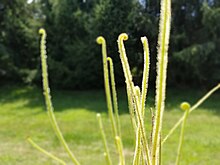Drosera
| Drosera | |
|---|---|

| |
| Drosera anglica | |
| Scientific classification | |
| Kingdom: | |
| (unranked): | |
| (unranked): | |
| (unranked): | Core eudicots
|
| Order: | |
| Family: | |
| Genus: | Drosera |
Drosera, sometimes called Sundews, are carnivorous plants. They use a thick gluey mucilage to trap and digest their prey.The mucilage is attached to special hairs called trichomes. They are one of the most common carnivorous plants. They have at least 188 species.[1] They are found everywhere in the world except Antarctica.[2] Many sundews species usually live for two or more years. Others live for only one year and reproduce by seed. Some sundew species can live for 50 years.[3]
Description[change | change source]
Its scientific name is from the Greek δρόσος: "drosos" = "dew, dewdrops". Its English name is sundew, from Latin ros solis, meaning "dew of the sun". Both names describe the sweet-smelling, sticky mucilage (goo) that comes down the ends of tentacles on each flower stalk.[2] This mucilage rolls down the plant, attracting sugar-loving insects day and night.[2] The mucilage has enzymes which digests them so that the plants can get the nitrogen it needs from it. Like all plants, the sundew makes its own food, and just uses insects for nitrogen and other nutrients. The insects are used to supplement the poor mineral nutrition of the soil in which the plants grow.
These tiny flowering plants are about 5 in (127 mm) tall,[2] about as tall as an adult's hand, though some climbing sundews can be much taller. One species of sundew, the Drosera erythrogyne, grows up to 30 ft (9 m).[4] Sundew roots are not very strong. They are usually simply for taking in water and keeping the sundew firmly planted to the ground.
What they eat[change | change source]

A fly, butterfly, or other nectar-loving insect will find the sweet smell of the mucilage that oozes from the plant. Landing on the colorful tip, the insect will immediately be stuck.[2] The plant has cells that make more mucilage in the place where the insect is. The gooey mucilage will completely surround the insect. Then, the sundew plant wraps its outside tentacles around the insect, absorbing its nutrients. It curls its tentacles around the insect quite quickly: in some species this takes only a few seconds. Some species, like Drosera glanduligera can curl its tentacles towards its prey in less than a second.[5] Many sundews can bend parts of themselves so that the prey will be as sticky as possible. One species, Drosera capensis, actually wraps its leaf around the prey in 30 minutes, as seen in the picture on the right. The prey usually dies in about 15 minutes.[6] The sundew will then absorb the entire insect except the outside exoskeleton. When the plant has finished eating, it opens up its tentacles and drops what's left of the insect to the ground.[2]
Other uses[change | change source]
Sundews have also been used in herbal medicine for a long time. Today they are still used to stop coughs, asthma, and lung infections.
Because they are carnivorous (eat living things), and because of the beauty of the dew-like mucilage on their tentacles, sundews are also popular as ornamental plants. However, they can be quite hard to grow: they need lots of water (their soil usually has to keep on being very wet), and this water has to be pure (without minerals inside it), because this can stop them from growing or even kill them.
Parts of sundews were also eaten by Australian Aborigines.[7]

References[change | change source]
- ↑ McPherson S.R. 2008. Glistening carnivores. Redfern Natural History Productions, Poole.
- ↑ 2.0 2.1 2.2 2.3 2.4 2.5 Slack A 1988. Carnivorous plants. London: Alphabooks. ISBN 0-7136-3079-5.
- ↑ Karnivoren Biologie und Kultur Fleischfressender Pflanzen (in German). Verlag Eugen Ulmer. 2004. p. 102. ISBN 978-3-8001-4144-9.
{{cite book}}: Cite uses deprecated parameter|authors=(help) - ↑ Mann, Phil. "World's largest Drosera". Carnivorous Plants of Western Australia. Archived from the original on 29 September 2011. Retrieved 27 January 2010.
- ↑ Hartmeyer I. & S. 2005. Drosera glanduligera: Der Sonnentau mit "Schnapp-Tentakeln", DAS TAUBLATT (GFP): 34-38
- ↑ Charles Darwin (1875). Insectivorous Plants. Archived from the original on 2005-07-20. Retrieved 2010-01-27.
- ↑ Barthlott et al., Karnivoren, p. 100
Other websites[change | change source]
- A key to Drosera species, with distribution maps and growing difficulty scale Archived 2008-02-18 at the Wayback Machine
- A virtually exhaustive listing of Drosera pictures on the web
- International Carnivorous Plant Society
- Carnivorous Plant FAQ
- Listing of scientific Drosera articles online (terraforums.com) Archived 2007-11-24 at the Wayback Machine
- The Sundew Grow Guides Archived 2010-02-19 at the Wayback Machine
- Sundew images from smugmug
- Botanical Society of America, Drosera - the Sundews Archived 2010-06-13 at the Wayback Machine
- An editor's website
